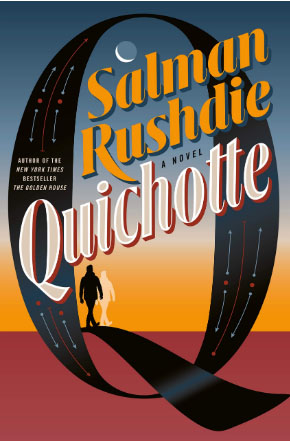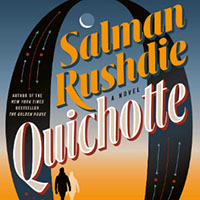— from Jens Kruse —
There once lived, at a series of temporary addresses across the United States of America, a travelling man of Indian origin, advancing years, and retreating mental powers, who, on account of his love for mindless television, had spent far too much of his life in the yellow light of tawdry motel rooms watching an excess of it, and had suffered a peculiar form of brain damage as a result.
Thus opens Salman Rushdie’s novel Quichotte, signaling that we are in for, among other things, an early 21st Century update of Cervantes’ novel.
Late in the novel we hear of the writer of the story (yes, the author becomes a character within the narrative) that:
[h]e tried to explain the picaresque tradition. Its episodic nature, and how the episodes of such work could encompass many manners, high and low, fabulist and commonplace, how it could be at once parodic and original, and so through its metamorphic roguery it could demonstrate and seek to encompass the multiplicity of human life. (362)

And, indeed, between these passages Rushdie unleashes a dizzying cornucopia of stories, themes, forms and modes: the complicated stories of Indian immigrants to Britain and the United States; the gaining of material riches and losing of spiritual wealth; the search for love expressed in the delusional adoration of TV personalities; hacking and cyber warfare; the opioid epidemic; the tragic and comedic; the hilarious and the sad.
All of this unfolds in a world that is most dominantly characterized by the smudging of the line between fact and fiction, truth and lies, reality and unreality. It is an “Age of Anything-Can-Happen” (7).
Or, as the writer-character of the novel explains, he wanted:
to take on the destructive, mind-numbing junk culture of his time just as Cervantes had gone to war with the junk culture of his own age. He said he was trying to write about impossible, obsessional love, father-son relationships, sibling quarrels, and yes, unforgivable things; about Indian immigrants, racism towards them, crooks among them; about cyber-spies, science fiction, the intertwining of fictional and “real’” realities, the death of the author, the end of the world. (289)
To call this an ambitious program would be an understatement. And I have not even mentioned yet how Quichotte creates his son Sancho by means of prayer during the Perseids meteor shower near the Devils Tower in Wyoming, how the very fabric of space-time begins to unravel, and how human beings transformed into Mastodons rampage through the streets of a small town in New Jersey, causing Quichotte to reflect:
Not all metamorphoses are capable of being reversed (…) At a certain point, a tipping point, if you will, we may have to accept that these mastodons are citizens just like us, and we will have to find a way to bridge the gap between us, however hostile toward us, however ignorant and prejudiced, they may appear. (185)
How Rushdie manages to bring all these strands together in a daring, delightful, and delicious denouement I will not reveal here, dear reader, because I do not want to deprive you of the pleasure of the novel’s ending.
But I will say this. In many of my book reviews for Orcas Issues I have discussed non-fiction books that I hoped would help us to better understand and navigate our disorienting and perilous moment in time. It is an interesting surprise and a testament to the power of Rushdie’s imagination and of his writing that this work of fiction may well be the best guide yet to the United States in the last few years.
Quichotte. A Novel. (New York: Random House, 2019) can be checked out from the Orcas Library. It is available through Darvill’s Bookstore.
**If you are reading theOrcasonian for free, thank your fellow islanders. If you would like to support theOrcasonian CLICK HERE to set your modestly-priced, voluntary subscription. Otherwise, no worries; we’re happy to share with you.**









Thank you for this wonderful taste of what sounds to be a great novel! Keep up the reviews, please!
Thank you, Tracy. Will try.